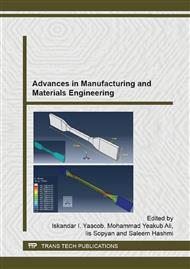p.503
p.509
p.513
p.517
p.523
p.527
p.531
p.535
p.539
Simulation of Low Velocity Impact Test on Carbon/Epoxy Composite Plates
Abstract:
Composite materials that have low weight and high strength properties are currently one of the promising materials for a vehicle’s body. However, the effect of low velocity impact on composite may cause failure through matrix cracking, fibre breakage and delamination which may reduce the structure strength. Low velocity impact can be analysed either by experimentation or numerical simulation. Numerical simulation which is also known as finite element analysis can show the degradation of the composite structure properties after an impact loading condition without doing any experimentation. Thus, in this paper, LS-DYNA is the finite element analysis software that is used to simulate a low velocity impact on composite structures.
Info:
Periodical:
Pages:
523-526
Citation:
Online since:
July 2015
Authors:
Keywords:
Price:
Сopyright:
© 2015 Trans Tech Publications Ltd. All Rights Reserved
Share:
Citation:


